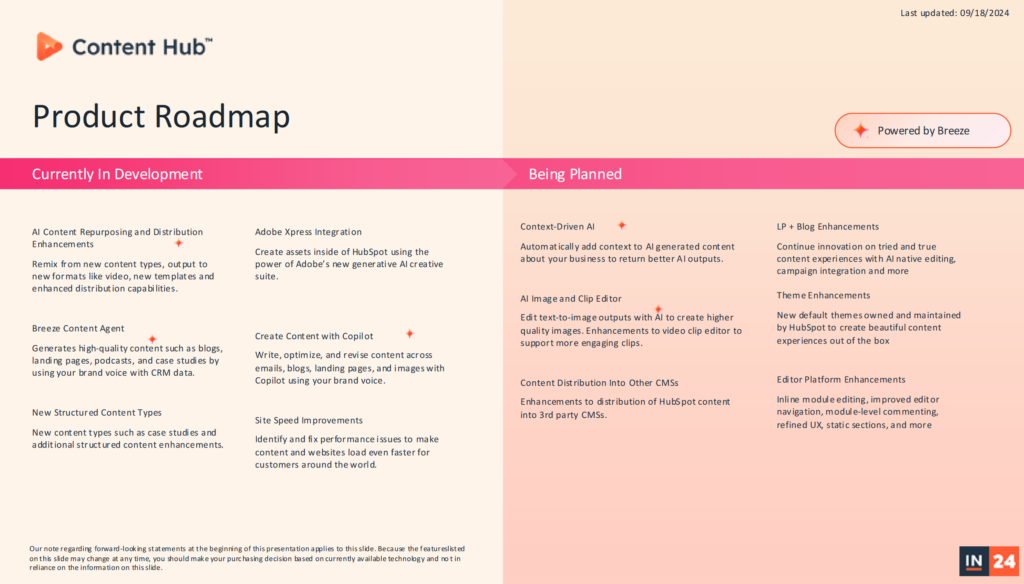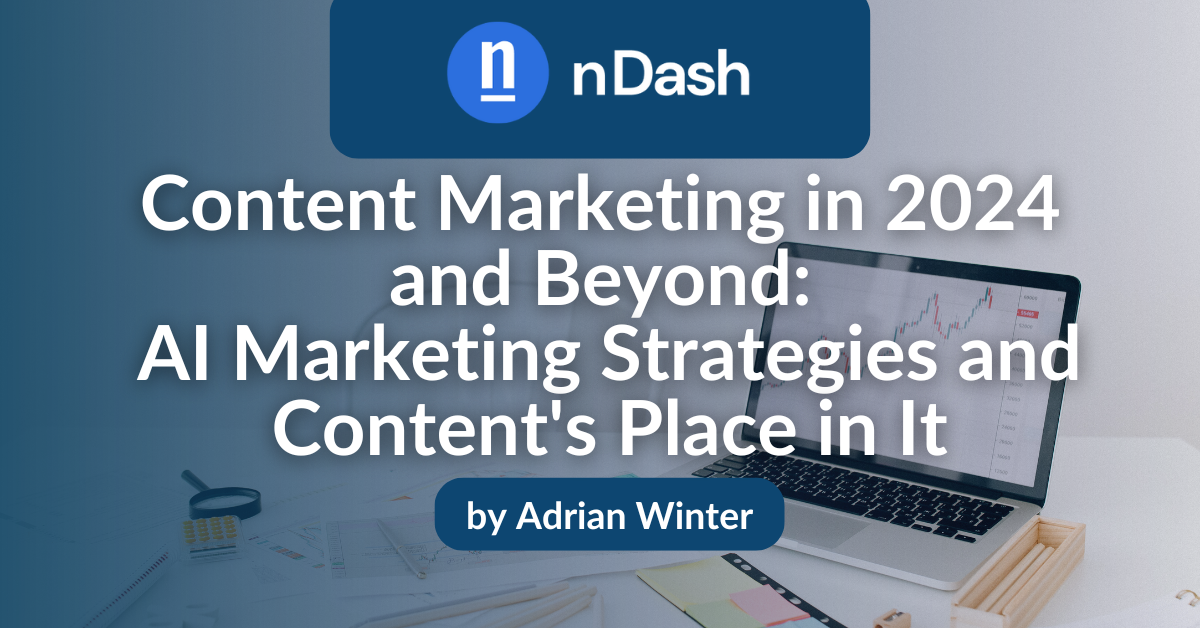As content marketers, algorithms and search trends dominate our lives. So, with numerous recent shake-ups, Content Marketing Reinvented was at the top of my list.
The Evolution of Content Marketing
Gabe Wahhab and Matt Schnitt (both from Hubspot) led this session during INBOUND 24:
Content Marketing Reinvented: How To Win in an AI Landscape | INBOUND 2024 – HubSpot’s Marketing & Sales Conference | Sept 18-20, 2024
They promised to shed light on the evolution of marketing from the early 2010s to the present. This included examining why the things that worked then weren’t as effective now. Lastly, they covered what today’s marketers can do to freshen up their content marketing strategy.
To kick things off, Gabe and Matt asked the audience how they would rate their marketing performance. Then, they were invited to name what they thought was the reason. Here are the most frequently cited challenges content marketers face:
- Department culture (infighting vs. support)
- Too little time or too few resources
- Lack of communication with sales
Next came a brief primer on the transition from inbound marketing to AI-focused marketing. It was informative, highlighting where old best practices originate. It made for a natural segue into their content marketing plan for the near future.
The latter portion of the session was dedicated to showcasing HubSpot’s new Content Hub platform. They demonstrated how audience members could use it to act on their advice and incorporate AI into their marketing.

Inbound Marketing: the Bygone Days of Reader Magnets
HubSpot’s presenters began their retrospective by comparing the current marketing zeitgeist to that of the early 2010s. It was an exciting time, a sort of Cambrian explosion. Social media platforms flourished, and omnichannel marketing was just getting off the ground. Content was king and still is, according to over 80% of marketers. But beyond that and an optimistic excitement around new marketing tools, there aren’t many similarities.
What’s Changed for Content Marketing?
The biggest change in content marketing is the cratering of search traffic. There are several reasons for this, including:
- The continued dominance of zero-click searches
- AI queries replacing search engine usage
- Audio and video formats replacing text as the primary vehicle for consuming content
These culprits are the changes affecting modern marketing departments across every industry. Short-form vertical video dominates most platforms as they try to replicate TikTok’s runaway success. Despite this, people have a more diversified media diet than ever before.
So marketers have to include more dynamic content; text and static images just aren’t enough anymore. But this has its benefits, too. For example, studies show that people retain more information from audio and visual formats.
Another thing that is playing a bigger part is making sure you’re where people are going for their information. We know that search traffic to our websites is dropping, so where are they going instead?
Trust is Shifting. Marketers Must Adapt.
The other major change is who people consider to be a trusted source of information these days. Most people prefer to get their news, recommendations, and messaging from individuals rather than brands.
One way that content marketing managers are meeting this challenge is by becoming creators that people can follow. That’s why we’re seeing brands become more comedic, sassy, or conversational. The idea is to create more personality. We’re also seeing YouTube and TikTok channels with light branding. They focus on providing information and value rather than sales pitches and CTAs.
Another is increasing activity on websites like Quora and Reddit to establish their brand’s authority. It’s a response to the trend of adding “Reddit” to search queries to improve result quality.
What Should Your Content Look Like Now?
In short, it should look as many different ways as possible while maintaining a high level of quality. Fluff for the sake of posting frequently isn’t enough now (if it ever was).
The trick is providing immediate value to your audience. It’s even better if it’s as tailored to the individual as you can manage. Most importantly, they publish on the platforms they already use. This is how you create loyal followers who will go to you for their needs and amplify your message to others.
However, content marketers are already short on time and resources. So, how can you split your content into as many formats as possible?
Incorporating AI into Your Content Marketing Strategy
Gabe and Matt’s action plan involves heavily relying upon and working with AI. They do this in two ways: catering to AI’s sourcing preferences and employing it directly.
With AI snatching traffic from traditional search engines, your best strategy is to make sure AI uses your content. This is done by focusing on being a subject-matter expert on a few core topics. Keep the breadth limited instead of trying to be all things to all people. Also, remember that it’s much easier to rank for topics that don’t have a clear, cut, and dry answer. The rest is just making sure that you’re regularly refreshing the content with new research and insights.
On the other side of the equation, put AI to work for you. Matt and Gabe recommended using AI as an entry-level employee. Dedicate AI to execution so that you can focus on ideation. Some use cases they put forward for AI as part of your content and marketing ecosystem:
- Translating website content into languages with good traffic volume
- Building interactive experiences such as graders
- Personalizing and optimizing customer journey touchpoints
- Turning blog posts into podcast episodes or videos (and vice versa!)
Now, does this involve learning yet another tool or piece of software? It doesn’t have to. HubSpot’s comprehensive Content Hub offers many of the solutions proposed in Gabe and Matt’s talk so far.
They walked the audience through using Content Hub to generate, tweak, and personalize marketing content. This allows marketers to create a tailored marketing strategy that doesn’t strain your marketing budget or team.

Key Takeaways for Content Marketers
There was a lot to ingest for anyone in a marketing department. But if you’re in a hurry, here are the three big ideas:
Focus on Quality Over Quantity
Build a library of valuable content on the platforms your audience already uses. Make sure it’s authentic and well-considered.
Create Like a Media Company
The omnichannel approach to content marketing is becoming more of an omni-format approach. You don’t have to be everywhere, but audiences need to be able to find you. Be sure the information to their queries is available in audio, video, and text formats.
Become AI’s Primary Source
Create well-researched, well-linked content in different formats. Target more generic queries to which there are multiple answers. And then keep it up-to-date.
Is AI a Silver Bullet for Content Marketing?
The session was a decent mix of education and sales pitch. However, most of Content Hub’s features are AI services. So, how do content marketers avoid the temptation to have it create most of their material?
There are a few reasons why you should avoid leaning too heavily on AI content creation for your marketing campaigns. If everyone uses the same AI to create their content, it’s going to be difficult to differentiate your brand. This leaves your content lost in a sea of sameness.
Marketing professionals also miss an opportunity to hone their writing and designing skills. Knowing how to write good AI prompts and fine-tune the results shouldn’t be the only tool in your arsenal.
HubSpot is on the right track when they suggest AI as an entry-level employee. But perhaps a personal assistant is more accurate. AI is something to cover the tedious grunt work of data entry, scheduling posts, or generating hashtags. However, AI shouldn’t be entrusted with sole stewardship of your brand’s voice.
About the Author
 Adrian Winter is a seasoned writer and marketer with a decade of experience in transforming events into profit centers and crafting impactful content across print and digital platforms. He specializes in growing audiences and delivering dynamic, results-driven materials.
Adrian Winter is a seasoned writer and marketer with a decade of experience in transforming events into profit centers and crafting impactful content across print and digital platforms. He specializes in growing audiences and delivering dynamic, results-driven materials.
Check out Adrian’s nDash writing profile here: Adrian Winter.
